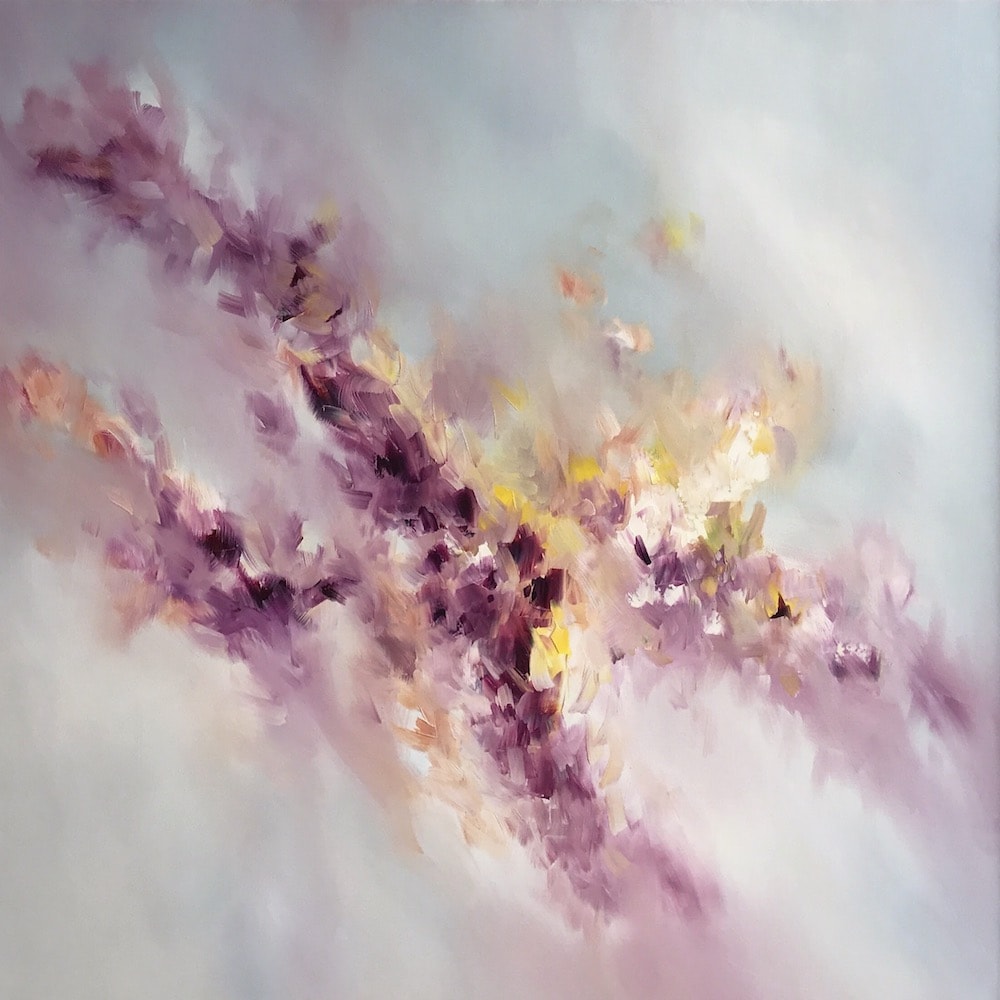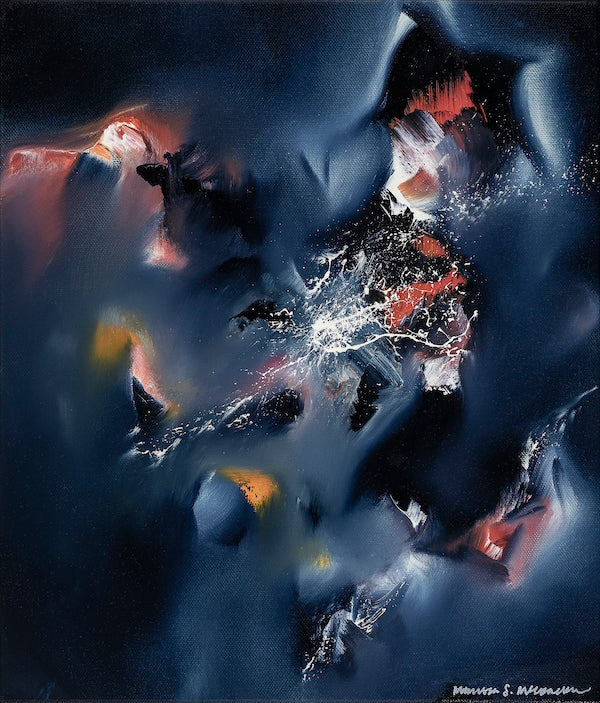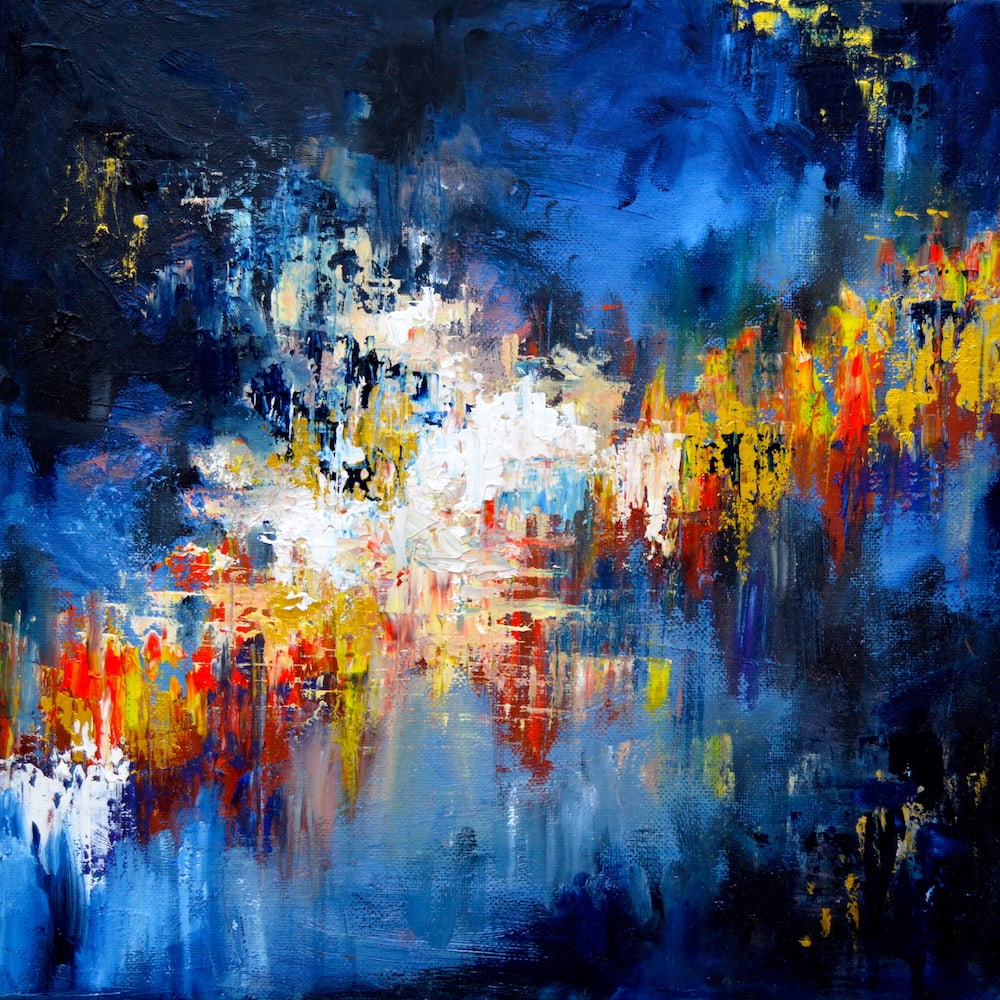We’ll begin this article by having artist Melissa McCracken give us a short introduction to synesthesia and how it inspires her artwork.
Melissa McCracken: Synesthesia is a neurological condition in which the brain’s senses are cross-wired. So, in my case, whenever I hear music, the color faculty of my brain is triggered at the same time. it’s involuntary and simultaneous – an automatic response to music. Synesthesia can occur in a number of different ways. Any of the senses can be cross-wired. I have a form called grapheme synesthesia, in which, if I’m reading a book, all the letters and numbers are color coded as well. Spatial synesthesia is another [type that I have], where days of the week and numbers or anything that’s sequential is mapped out around my physical body or in my mind in specific places. It’s basically just my senses overlapping in a way they wouldn’t normally in a neuro-typical brain.
Alón Sagee: How did you discover that you had Synesthesia?
MM: When I was about 16, I honestly had never even given a thought that other people may not experience music as color, probably because there’s such a high association between visuals and music – you know, album artwork and music videos and light shows at concerts. It just kind of seemed natural to have that colorful component to it. And when I was trying to find a ringtone for my phone (laughs) I was consulting a friend on it and was talking about how this song matched my phone better. And he kind of stopped me in my tracks and said, “what are you talking about?” I was just amazed that he hadn’t had the same experience.
I thought that something must be different in his brain because the color/sound connection just seemed so apparent to me. So, we explored that conversation and not long after I opened it up to some other friends and family members and started to get a better idea of the way my brain was wired. I found out that synesthesia wasn’t very common but nevertheless it actually ended up being discussed in one of my college psychology courses! The professor asked if anyone had experience with synesthesia and since I was familiar with it and pretty sure that was what I had, I raised my hand. Hearing his analysis convinced me that this is what I have. I ended up speaking to the whole class about my experiences. So, it was relatively late in my life to understand that, you know, something was a little bit different about me.

Melissa McCracken.
AS: Was it difficult as a youth to have this special ability that other people didn’t have?
MM: I think in some ways it was very helpful. I remember that math was a fairly easy subject for me since I see numbers in all their different individual colors. This made it easier for me to remember formulas because I’d be familiar with what colors were in that formula. It’s like a mnemonic device for remembering a lot of things, but it kind of would get in the way sometimes, like when meeting people. I’ll know they have a blue name, but I wonder, does it start with an “A,” does it start with an “F”…? And then alongside that, the relatability of having these experiences with music. I’m very passionate about music and it can be – I wouldn’t say frustrating, but kind of a moment of mismatch knowing that I’m having these experiences and they’re not exactly transferable or relatable to someone else. So, I think that sometimes that was a little upsetting to me, which is why I started painting – just to connect that a little bit better into the real world and with other people. So yeah, I don’t think it was much of a hindrance, but there were ups and downs to it, for sure. (laughs)
AS: Is this something that’s on all the time or can you turn it on and off?
MM: It’s involuntary, so it’s just always happening. I may not pay attention to it as much, you know, just like if I might be more in tune to the smells of the room or the conversation that I’m having rather than just focusing on the colors that are being expressed through the music [that’s playing] at that moment. So, I’ll tune in and tune out, but it’s never gone…

A Sunday Night (2018).

Wash (2018).
AS: Is this related to anything else that you experience? For example, years and years ago, I was taught how to focus and relax my sight to see auras around people.
MM: Oh, really?
AS: Yeah. It’s really weird and fascinating. I don’t tell too many people that, but now it’s it’ll be in print, so I’m sure to get some (ahem) comments.
MM: (laughs) Okay. Wow. That’s really cool though.
AS: I could see a yellow glow around people, especially around their heads. So I can relate to what you’re saying a little bit, although I wish I was a good visual artist. I’m not.
MM: (laughs) I actually can relate specifically to that – my roommate and I are interested in those sorts of topics and we’ve talked a lot about auras and things like that. And I think there does seem to be a spiritual connection to it just because it feels like more of an impression of the feelings the music evokes, rather than a very literal translation of what I’m experiencing, but I don’t know if that’s the same concept as feeling the aura of a song, you know what I mean?

Ghosts (2018).

Kiss the Earth (2018).
AS: Yeah, it’s fascinating stuff. One thing I’m fairly sure of is that our audiophile community would be interested in your process. How do you start a painting? Do you start with a song in your head? Is the song playing on a loop in your mind, or does it all show up at once?
MM: There are a lot of components to it. You know, a song is typically [around] four minutes long, so there’s a lot of different things happening in the visuals that aren’t stagnant, that have a lot of movement to them. I’ve tried a bunch of different approaches and [they’ll] vary from piece to piece. Many times, I’d listen to a song on repeat, and then, to be honest, I stopped doing that as much, because I’d have my favorite songs that I wanted to paint and I’d get a little numb to them just because I’m orienting myself towards [them] in a very trying-to-figure-it-out sort of way, rather than just fully enjoying the music.
So, I’ve learned to listen to a song a couple of times and kind of get a good understanding of the overall feel that I wanna get across. And then maybe I’ll turn on a podcast or something like that. And then intermittently go back to the song and make sure that – I don’t know how else to put it other than that I’m still incorporating those elements of the song that feel powerful. I relate it to the idea of creating a movie poster. You’re not putting all the scenes [in the movie] on the poster, but you’re really trying to get across the highlights. And so it’s like a screenshot in time, but at the same time a collage, and I try to make sure there’s movement in there to kind of give context to how these colors or shapes play into the song itself.
AS: It seems that the places where your paintings want to go don’t unfold all at once. Can you hear a song on the radio and then go home and paint it without putting the song back on?
MM: There’s a visual memory [aspect]. I do like to have the song [playing] as a reference because there are things I can come up with that I might have forgotten about. One of my favorite artists is Nine Inch Nails. I love Trent Reznor; his music has so much detail. There’s a lot of depth in the experience is of listening to NIN or his solo work. I think what’s cool about that is I can turn on a song that I’ve been so familiar with and notice a new little bass line or – I’m not super-technical with music, so I can’t speak [about] it in that way, but I’ll notice little elements of it that I haven’t previously experienced and that will change the picture. It’s important for me to stay in tune with the song.
Stay tuned for Part Two of this interview in our next issue.
Here’s the full list of Melissa’s paintings inspired by music: https://www.melissasmccracken.com/song-list
******
Copper Community Engagement:
Has one or more of the paintings inspired by a piece of music touched you in some way? Please share your experience by submitting a comment.
Alón Sagee is Chairman and Chief Troublemaker of the San Francisco Audiophile Society. Alón’s writings for Copper can be found in the following issues:
- A Pre-Entry-Level Analog MP3 Killer
- The Audiophile’s Opinion/Audio Clubs
- The Audiophile’s Brain
- The Audiophile’s Cat
- Chinese Food for Thought
- The Not-So-Great Wall
- Everest, Part 1
- Everest, Part 2
- Everest, Part 3
- Mongolia, Part 1
- Mongolia, Part 2
- Two Hands Clapping
- Sublime Moments
Also, please note: Alón’s biography for the Francisco Audiophile Society.
Header image: Gravity (2014), by Melissa McCracken. All images courtesy of Melissa McCracken.


